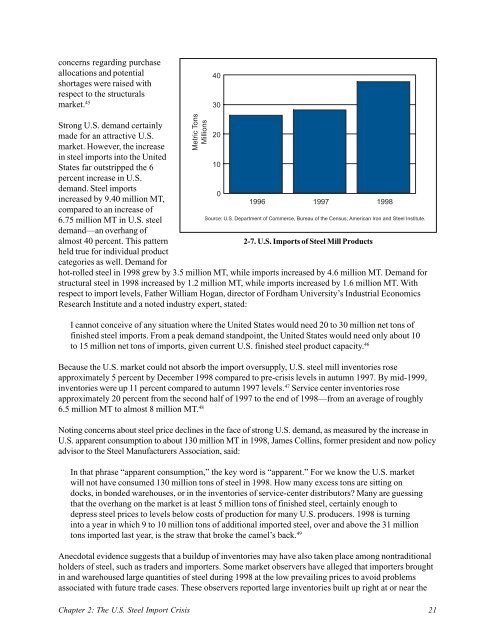Global Steel Trade; Structural Problems and Future Solutions
Global Steel Trade; Structural Problems and Future Solutions
Global Steel Trade; Structural Problems and Future Solutions
Create successful ePaper yourself
Turn your PDF publications into a flip-book with our unique Google optimized e-Paper software.
concerns regarding purchase<br />
allocations <strong>and</strong> potential<br />
shortages were raised with<br />
respect to the structurals<br />
market. 45<br />
40<br />
30<br />
Strong U.S. dem<strong>and</strong> certainly<br />
made for an attractive U.S.<br />
market. However, the increase<br />
in steel imports into the United<br />
States far outstripped the 6<br />
percent increase in U.S.<br />
dem<strong>and</strong>. <strong>Steel</strong> imports<br />
increased by 9.40 million MT,<br />
compared to an increase of<br />
6.75 million MT in U.S. steel<br />
dem<strong>and</strong>—an overhang of<br />
almost 40 percent. This pattern<br />
held true for individual product<br />
categories as well. Dem<strong>and</strong> for<br />
Metric Tons<br />
Millions<br />
20<br />
10<br />
0<br />
1996 1997 1998<br />
Source: U.S. Department of Commerce, Bureau of the Census; American Iron <strong>and</strong> <strong>Steel</strong> Institute.<br />
2-7. U.S. Imports of <strong>Steel</strong> Mill Products<br />
hot-rolled steel in 1998 grew by 3.5 million MT, while imports increased by 4.6 million MT. Dem<strong>and</strong> for<br />
structural steel in 1998 increased by 1.2 million MT, while imports increased by 1.6 million MT. With<br />
respect to import levels, Father William Hogan, director of Fordham University’s Industrial Economics<br />
Research Institute <strong>and</strong> a noted industry expert, stated:<br />
I cannot conceive of any situation where the United States would need 20 to 30 million net tons of<br />
finished steel imports. From a peak dem<strong>and</strong> st<strong>and</strong>point, the United States would need only about 10<br />
to 15 million net tons of imports, given current U.S. finished steel product capacity. 46<br />
Because the U.S. market could not absorb the import oversupply, U.S. steel mill inventories rose<br />
approximately 5 percent by December 1998 compared to pre-crisis levels in autumn 1997. By mid-1999,<br />
inventories were up 11 percent compared to autumn 1997 levels. 47 Service center inventories rose<br />
approximately 20 percent from the second half of 1997 to the end of 1998—from an average of roughly<br />
6.5 million MT to almost 8 million MT. 48<br />
Noting concerns about steel price declines in the face of strong U.S. dem<strong>and</strong>, as measured by the increase in<br />
U.S. apparent consumption to about 130 million MT in 1998, James Collins, former president <strong>and</strong> now policy<br />
advisor to the <strong>Steel</strong> Manufacturers Association, said:<br />
In that phrase “apparent consumption,” the key word is “apparent.” For we know the U.S. market<br />
will not have consumed 130 million tons of steel in 1998. How many excess tons are sitting on<br />
docks, in bonded warehouses, or in the inventories of service-center distributors? Many are guessing<br />
that the overhang on the market is at least 5 million tons of finished steel, certainly enough to<br />
depress steel prices to levels below costs of production for many U.S. producers. 1998 is turning<br />
into a year in which 9 to 10 million tons of additional imported steel, over <strong>and</strong> above the 31 million<br />
tons imported last year, is the straw that broke the camel’s back. 49<br />
Anecdotal evidence suggests that a buildup of inventories may have also taken place among nontraditional<br />
holders of steel, such as traders <strong>and</strong> importers. Some market observers have alleged that importers brought<br />
in <strong>and</strong> warehoused large quantities of steel during 1998 at the low prevailing prices to avoid problems<br />
associated with future trade cases. These observers reported large inventories built up right at or near the<br />
Chapter 2: The U.S. <strong>Steel</strong> Import Crisis 21
















